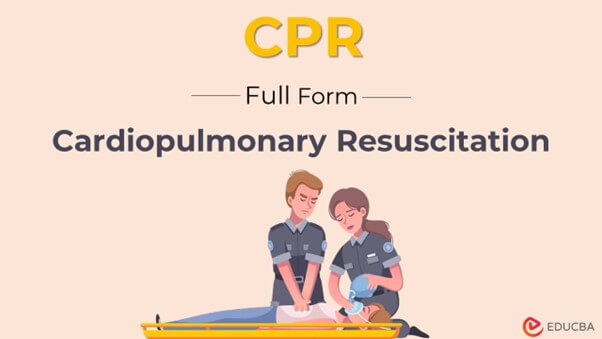Full Form of CPR- Cardiopulmonary Resuscitation
The full form of CPR is Cardiopulmonary Resuscitation. It is a set of abilities that can artificially restore oxygenated blood flow to someone whose heart has stopped beating normally. After the need for CPR has been established, the three main steps of the procedure are chest compressions, oxygenation, and defibrillation. When a person’s heart stops beating properly, these elements can be combined in various ways depending on the victim’s condition, the rescuer’s skill, and the equipment’s availability. By rapidly and forcefully pressing on the sternum, chest compressions during CPR allow artificial blood circulation.

What is the importance of CPR?
Before going into depth about anything, it becomes mandatory to know its importance so that its value and impact are understood. How to give Cardiopulmonary Resuscitation is something everyone has to know, and below are reasons why:
1. CPR saves lives:- CPR is an artificial way of kick-starting someone’s heart by rapidly pressing the sternum in intervals when it’s in cardiac arrest.
2. CPR saves almost 92,000 people in the US alone:- The numbers can be higher if more people are trained for CPR.
3. 75% of cardiac arrests happen at home:- Time is crucial when such an incident occurs at home. It takes a while for the ambulance to come when called; hence, if you know how to give a person CPR, you can save them.
4. CPR certification:- It provides individuals with the skills and knowledge necessary to respond effectively in life-threatening situations by administering cardiopulmonary resuscitation
5. Doubles a person’s chance of survival:- In some cases, when the ambulance cannot reach the person’s place on time, knowing CPR can double their chances of survival.
6. CPR skills deteriorate within three months of training:- It is not just that you learn CPR but also train yourself periodically.
There are many professionals who require CPR training for their line of work, like nurses, police officers, and firefighters, but it can be learned by anybody to be ready for emergencies.
How is CPR done?
CPR has to be performed effectively to ensure its purpose is served. You can remember the steps of CPR by remembering the mnemonic Drs. ABC (doctor’s ABC) where,
- D is for Danger: Before approaching, look around to ensure the area is secure for you and other people.
- R is for a reaction: Ask them loudly, “Are you okay?” and wait for a response. If they don’t respond, you must scream for assistance; any support will be beneficial.
You can carry out the subsequent actions to perform chest compressions:
- A is for Airway: Gently tilt the head back to widen the airway.
- B is for Breathing: Locate, Hear, and Feel for indications of regular breathing: Try to feel their breath against your face while keeping an eye out for regular chest movements and listening for normal breathing sounds.
- C is for Circulation: Circulation refers to blood movement throughout the body. When the heart has stopped pumping, we must assume control of circulation by rapidly and forcefully pressing down on the chest.
Begin by laying the heel of one hand at the person’s chest center and fusing your fingers. Press firmly and quickly while keeping your arms straight, letting your chest rise after each downward stroke. Hard implies that the chest must descend by roughly 5 centimeters, while fast indicates approximately two times per second. Although this may seem like a lot, you must try incredibly hard for it to be successful.
When should you perform CPR?
After understanding the full form of CPR and its importance, let us look at when you should perform it. Sometimes it can be very tricky to know if a person needs CPR. Here are some instances when a person might need CPR:
#1 When a person has collapsed and is not breathing:- If you see someone dropping to the ground suddenly and not seeing them breathing or struggling to breathe, they may need CPR.
#2 You don’t hear the heart beating:- If a person’s heart has stopped beating, they are having a cardiac arrest and need immediate CPR.
#3 They are unconscious:- If someone is unconscious and unresponsive when you try to wake them up, start with CPR.
#4. They are taking gasping breaths:- If a person struggles to breathe and cannot take full breaths, they might need CPR to clear the airway.
What are the preventive measures to keep in mind while giving CPR?
Before performing CPR, you must follow some precautions to ensure your and the person’s safety.
- Wear gloves to avoid touching the patient’s fluids with bare hands, which can cause infections.
- Baby and infant patients are much more delicate than adults, so consider that when applying the compressions.
- If you have masks, use them to protect your face and eyes from patient fluids.
- Only take action if you are sure of how it will work.
- If you are not professionally trained, perform hands-only CPR.
Conclusion
Cardiopulmonary Resuscitation or CPR is restoring oxygenated blood by artificially pumping it into a person. It is done by chest compressions and mouth-to-mouth breathing. CPR is an essential life-saving skill, considering most cardiac arrests happen at home. To perform CPR for a person who is unconscious or unable to breathe, remember the acronym DRs. ABC. Follow the precautions to minimize the risk of danger to yourself and the person. Hope this article has helped you understand the full form of CPR and the various facets related to it.
Recommended Articles
We hope that this EDUCBA information on “Full Form of CPR” was beneficial to you. You can view EDUCBA’s recommended articles for more information,


